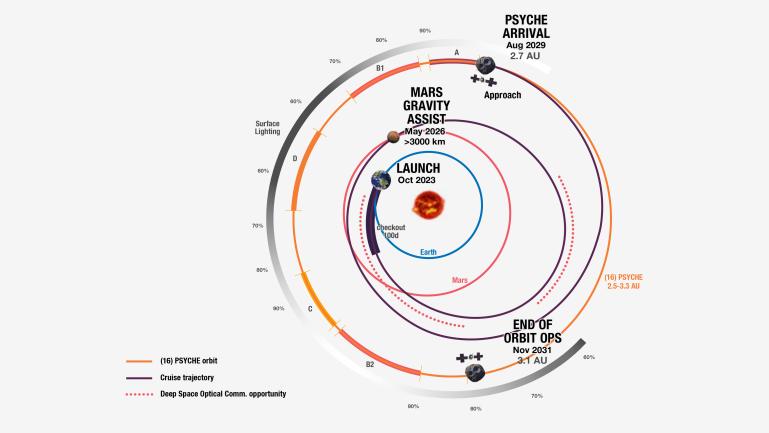Psyche Mission Timeline Image
NASA’s Psyche spacecraft takes a spiral path to the asteroid Psyche, as depicted in this graphic that shows the path from above the plane of the planets, labeled with key milestones of the prime mission. The test periods for NASA’s Deep Space Optical Communications (DSOC) technology demonstration are indicated with red dots.
This graphic has been updated to reflect a launch scheduled for October 2023.
After launch, the Psyche spacecraft is expected to fly by Mars in May 2026. (The spacecraft’s trajectory from Earth to the asteroid is shown in dark purple.) Harnessing the Red Planet’s gravity, Psyche will use the speed at which Mars travels around the Sun to increase the spacecraft’s own speed and change its direction without using much propellant. This effect is similar to how a ball thrown at a moving train will bounce off the train in another direction at a higher speed.
Psyche will travel into the main asteroid belt, where the gravity of its namesake asteroid is expected to capture the spacecraft in July 2029. The spacecraft’s orbital operations start in August 2029 (marked here as “Psyche arrival”).
The spacecraft’s various orbits around the asteroid are named alphabetically from highest (A) to lowest (D), but they don’t proceed in alphabetical order. Rather, they proceed based on the changing amount of sunlight illuminating the asteroid’s surface during observation and the kind of science that can be done. Because sunlight will illuminate less and less of the asteroid’s surface when the first part of Orbit B begins, this orbit is split into two parts, B1 and B2, so that the spacecraft can complete its mapping of the asteroid. A black-and-white arc around the outer edge of the graphic shows how much of the surface will be illuminated during the spacecraft’s time at the asteroid.
Arizona State University leads the Psyche mission. A division of Caltech in Pasadena, NASA’s Jet Propulsion Laboratory is responsible for the mission’s overall management, system engineering, integration and test, and mission operations. Maxar Technologies in Palo Alto, California, provided the high-power solar electric propulsion spacecraft chassis.
JPL also is providing DSOC, which will fly on Psyche in order to test high-data-rate laser communications that could be used by future NASA missions.
For more information about NASA’s Psyche mission, go to:
http://www.nasa.gov/psyche or https://psyche.asu.edu/


